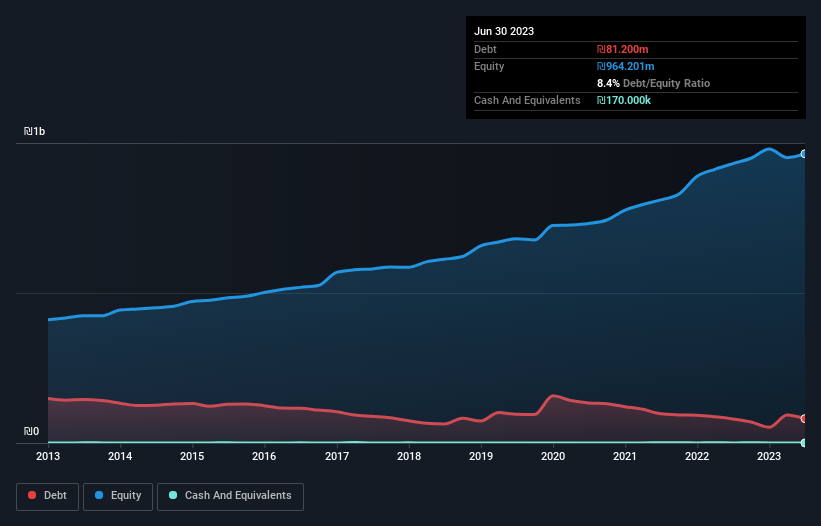- Israel
- /
- Real Estate
- /
- TASE:HRON
Is Hiron-Trade Investments & Industrial Buildings (TLV:HRON) A Risky Investment?

The external fund manager backed by Berkshire Hathaway's Charlie Munger, Li Lu, makes no bones about it when he says 'The biggest investment risk is not the volatility of prices, but whether you will suffer a permanent loss of capital.' It's only natural to consider a company's balance sheet when you examine how risky it is, since debt is often involved when a business collapses. As with many other companies Hiron-Trade Investments & Industrial Buildings Ltd (TLV:HRON) makes use of debt. But should shareholders be worried about its use of debt?
When Is Debt A Problem?
Generally speaking, debt only becomes a real problem when a company can't easily pay it off, either by raising capital or with its own cash flow. Part and parcel of capitalism is the process of 'creative destruction' where failed businesses are mercilessly liquidated by their bankers. While that is not too common, we often do see indebted companies permanently diluting shareholders because lenders force them to raise capital at a distressed price. By replacing dilution, though, debt can be an extremely good tool for businesses that need capital to invest in growth at high rates of return. The first thing to do when considering how much debt a business uses is to look at its cash and debt together.
Check out our latest analysis for Hiron-Trade Investments & Industrial Buildings
What Is Hiron-Trade Investments & Industrial Buildings's Debt?
The chart below, which you can click on for greater detail, shows that Hiron-Trade Investments & Industrial Buildings had ₪81.2m in debt in June 2023; about the same as the year before. And it doesn't have much cash, so its net debt is about the same.

How Strong Is Hiron-Trade Investments & Industrial Buildings' Balance Sheet?
According to the last reported balance sheet, Hiron-Trade Investments & Industrial Buildings had liabilities of ₪106.8m due within 12 months, and liabilities of ₪209.2m due beyond 12 months. Offsetting this, it had ₪170.0k in cash and ₪20.5m in receivables that were due within 12 months. So it has liabilities totalling ₪295.4m more than its cash and near-term receivables, combined.
While this might seem like a lot, it is not so bad since Hiron-Trade Investments & Industrial Buildings has a market capitalization of ₪964.9m, and so it could probably strengthen its balance sheet by raising capital if it needed to. But it's clear that we should definitely closely examine whether it can manage its debt without dilution.
We measure a company's debt load relative to its earnings power by looking at its net debt divided by its earnings before interest, tax, depreciation, and amortization (EBITDA) and by calculating how easily its earnings before interest and tax (EBIT) cover its interest expense (interest cover). Thus we consider debt relative to earnings both with and without depreciation and amortization expenses.
Hiron-Trade Investments & Industrial Buildings's net debt is only 1.4 times its EBITDA. And its EBIT easily covers its interest expense, being 15.0 times the size. So we're pretty relaxed about its super-conservative use of debt. But the other side of the story is that Hiron-Trade Investments & Industrial Buildings saw its EBIT decline by 2.5% over the last year. That sort of decline, if sustained, will obviously make debt harder to handle. When analysing debt levels, the balance sheet is the obvious place to start. But you can't view debt in total isolation; since Hiron-Trade Investments & Industrial Buildings will need earnings to service that debt. So when considering debt, it's definitely worth looking at the earnings trend. Click here for an interactive snapshot.
Finally, a company can only pay off debt with cold hard cash, not accounting profits. So it's worth checking how much of that EBIT is backed by free cash flow. During the last three years, Hiron-Trade Investments & Industrial Buildings produced sturdy free cash flow equating to 79% of its EBIT, about what we'd expect. This free cash flow puts the company in a good position to pay down debt, when appropriate.
Our View
Hiron-Trade Investments & Industrial Buildings's interest cover suggests it can handle its debt as easily as Cristiano Ronaldo could score a goal against an under 14's goalkeeper. But truth be told we feel its EBIT growth rate does undermine this impression a bit. When we consider the range of factors above, it looks like Hiron-Trade Investments & Industrial Buildings is pretty sensible with its use of debt. While that brings some risk, it can also enhance returns for shareholders. When analysing debt levels, the balance sheet is the obvious place to start. But ultimately, every company can contain risks that exist outside of the balance sheet. These risks can be hard to spot. Every company has them, and we've spotted 1 warning sign for Hiron-Trade Investments & Industrial Buildings you should know about.
Of course, if you're the type of investor who prefers buying stocks without the burden of debt, then don't hesitate to discover our exclusive list of net cash growth stocks, today.
Valuation is complex, but we're here to simplify it.
Discover if Hiron-Trade Investments & Industrial Buildings might be undervalued or overvalued with our detailed analysis, featuring fair value estimates, potential risks, dividends, insider trades, and its financial condition.
Access Free AnalysisHave feedback on this article? Concerned about the content? Get in touch with us directly. Alternatively, email editorial-team (at) simplywallst.com.
This article by Simply Wall St is general in nature. We provide commentary based on historical data and analyst forecasts only using an unbiased methodology and our articles are not intended to be financial advice. It does not constitute a recommendation to buy or sell any stock, and does not take account of your objectives, or your financial situation. We aim to bring you long-term focused analysis driven by fundamental data. Note that our analysis may not factor in the latest price-sensitive company announcements or qualitative material. Simply Wall St has no position in any stocks mentioned.
About TASE:HRON
Hiron-Trade Investments & Industrial Buildings
Engages in the real estate business in Israel.
Adequate balance sheet average dividend payer.


